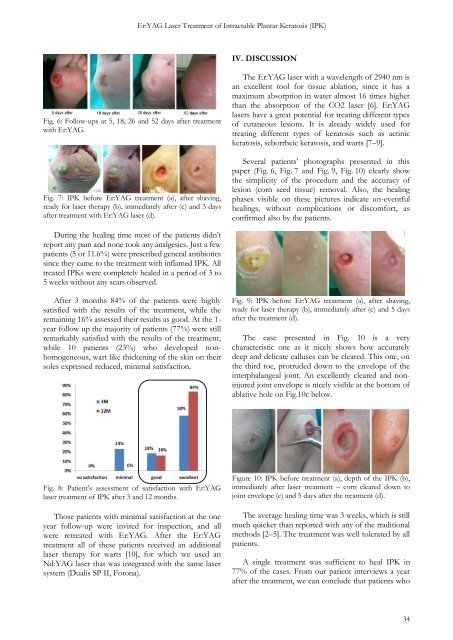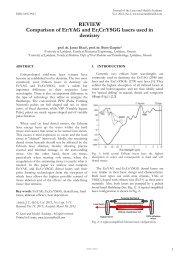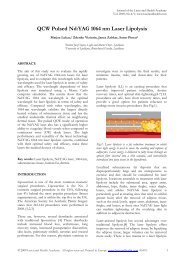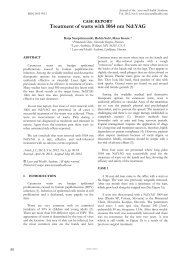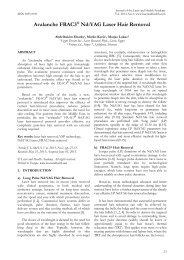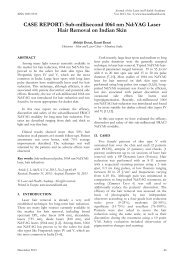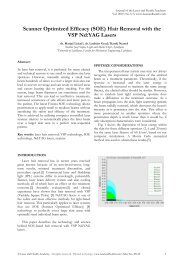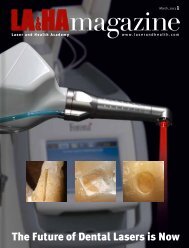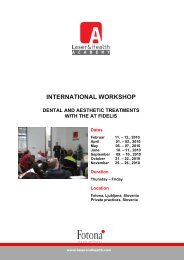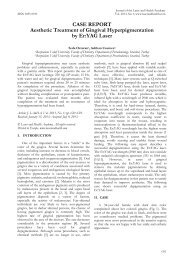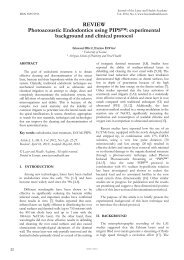Er:YAG Laser Treatment of Intractable Plantar Keratosis (IPK)
Er:YAG Laser Treatment of Intractable Plantar Keratosis (IPK)
Er:YAG Laser Treatment of Intractable Plantar Keratosis (IPK)
- No tags were found...
Create successful ePaper yourself
Turn your PDF publications into a flip-book with our unique Google optimized e-Paper software.
<strong>Er</strong>:<strong>YAG</strong> <strong>Laser</strong> <strong>Treatment</strong> <strong>of</strong> <strong>Intractable</strong> <strong>Plantar</strong> <strong>Keratosis</strong> (<strong>IPK</strong>)IV. DISCUSSIONFig. 6: Follow-ups at 5, 18, 26 and 52 days after treatmentwith <strong>Er</strong>:<strong>YAG</strong>.Fig. 7: <strong>IPK</strong> before <strong>Er</strong>:<strong>YAG</strong> treatment (a), after shaving,ready for laser therapy (b), immediately after (c) and 3 daysafter treatment with <strong>Er</strong>:<strong>YAG</strong> laser (d).The <strong>Er</strong>:<strong>YAG</strong> laser with a wavelength <strong>of</strong> 2940 nm isan excellent tool for tissue ablation, since it has amaximum absorption in water almost 16 times higherthan the absorption <strong>of</strong> the CO2 laser [6]. <strong>Er</strong>:<strong>YAG</strong>lasers have a great potential for treating different types<strong>of</strong> cutaneous lesions. It is already widely used fortreating different types <strong>of</strong> keratosis such as actinickeratosis, seborrheic keratosis, and warts [7–9].Several patients’ photographs presented in thispaper (Fig. 6, Fig. 7 and Fig. 9, Fig. 10) clearly showthe simplicity <strong>of</strong> the procedure and the accuracy <strong>of</strong>lesion (corn seed tissue) removal. Also, the healingphases visible on these pictures indicate un-eventfulhealings, without complications or discomfort, asconfirmed also by the patients.During the healing time most <strong>of</strong> the patients didn’treport any pain and none took any analgesics. Just a fewpatients (5 or 11.6%) were prescribed general antibioticssince they came to the treatment with inflamed <strong>IPK</strong>. Alltreated <strong>IPK</strong>s were completely healed in a period <strong>of</strong> 3 to5 weeks without any scars observed.After 3 months 84% <strong>of</strong> the patients were highlysatisfied with the results <strong>of</strong> the treatment, while theremaining 16% assessed their results as good. At the 1-year follow up the majority <strong>of</strong> patients (77%) were stillremarkably satisfied with the results <strong>of</strong> the treatment,while 10 patients (23%) who developed nonhomogeneous,wart like thickening <strong>of</strong> the skin on theirsoles expressed reduced, minimal satisfaction.Fig. 9: <strong>IPK</strong> before <strong>Er</strong>:<strong>YAG</strong> treatment (a), after shaving,ready for laser therapy (b), immediately after (c) and 5 daysafter the treatment (d).The case presented in Fig. 10 is a verycharacteristic one as it nicely shows how accuratelydeep and delicate calluses can be cleared. This one, onthe third toe, protruded down to the envelope <strong>of</strong> theinterphalangeal joint. An excellently cleared and noninjuredjoint envelope is nicely visible at the bottom <strong>of</strong>ablative hole on Fig.10c below.Fig. 8: Patient’s assessment <strong>of</strong> satisfaction with <strong>Er</strong>:<strong>YAG</strong>laser treatment <strong>of</strong> <strong>IPK</strong> after 3 and 12 months.Those patients with minimal satisfaction at the oneyear follow-up were invited for inspection, and allwere retreated with <strong>Er</strong>:<strong>YAG</strong>. After the <strong>Er</strong>:<strong>YAG</strong>treatment all <strong>of</strong> these patients received an additionallaser therapy for warts [10], for which we used anNd:<strong>YAG</strong> laser that was integrated with the same lasersystem (Dualis SP II, Fotona).Figure 10: <strong>IPK</strong> before treatment (a), depth <strong>of</strong> the <strong>IPK</strong> (b),immediately after laser treatment – corn cleared down tojoint envelope (c) and 5 days after the treatment (d).The average healing time was 3 weeks, which is stillmuch quicker than reported with any <strong>of</strong> the traditionalmethods [2–5]. The treatment was well tolerated by allpatients.A single treatment was sufficient to heal <strong>IPK</strong> in77% <strong>of</strong> the cases. From our patient interviews a yearafter the treatment, we can conclude that patients who34


